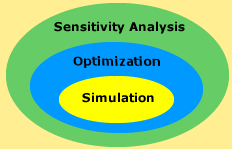
HOMER Pro 3.16

HOMER simplifies the task of designing distributed generation (DG) systems—both on- and off-grid. HOMER's optimization and sensitivity analysis algorithms allow you to evaluate the economic and technical feasibility of a large number of technology options and to account for variations in technology costs and energy resource availability.
Working effectively with HOMER requires understanding its three core capabilities; simulation, optimization, and sensitivity analysis; and how they interact.

Simulation, Optimization, and Sensitivity Analysis
Simulation: At its core, HOMER is a simulation model. It attempts to simulate a viable system for all possible combinations of the equipment you want to consider. Depending on how you set up your model, HOMER may simulate hundreds or even thousands of systems.
Optimization: The optimization step follows all simulations. The simulated systems are sorted and filtered according to criteria that you define, so you can see the best possible solutions. Although HOMER fundamentally is an economic optimization model, you may also choose to minimize fuel usage.
Sensitivity Analysis: This is an optional step that allows you to model the impact of variables that are beyond your control, such as wind speed and fuel costs, and see how the optimal system changes with these variations.
HOMER models both conventional and renewable energy technologies.
Power sources in HOMER •Solar photovoltaic (PV) •Wind turbine •Generator: diesel •Electric utility grid •Traditional hydro •Run-of-river hydro power •Biomass power •Generator: gasoline, biogas, alternative and custom fuels, cofired •Microturbine •Fuel cell |
|
Storage in HOMER •Flywheels •Customizable batteries •Flow batteries •Hydrogen |
|
Loads in HOMER •Get started quickly with the HOMER Quick Load Builder and built-in profiles •Daily profiles with seasonal variation •Deferrable (water pumping, refrigeration) •Thermal (space heating, crop drying) •Efficiency measures |
See also
